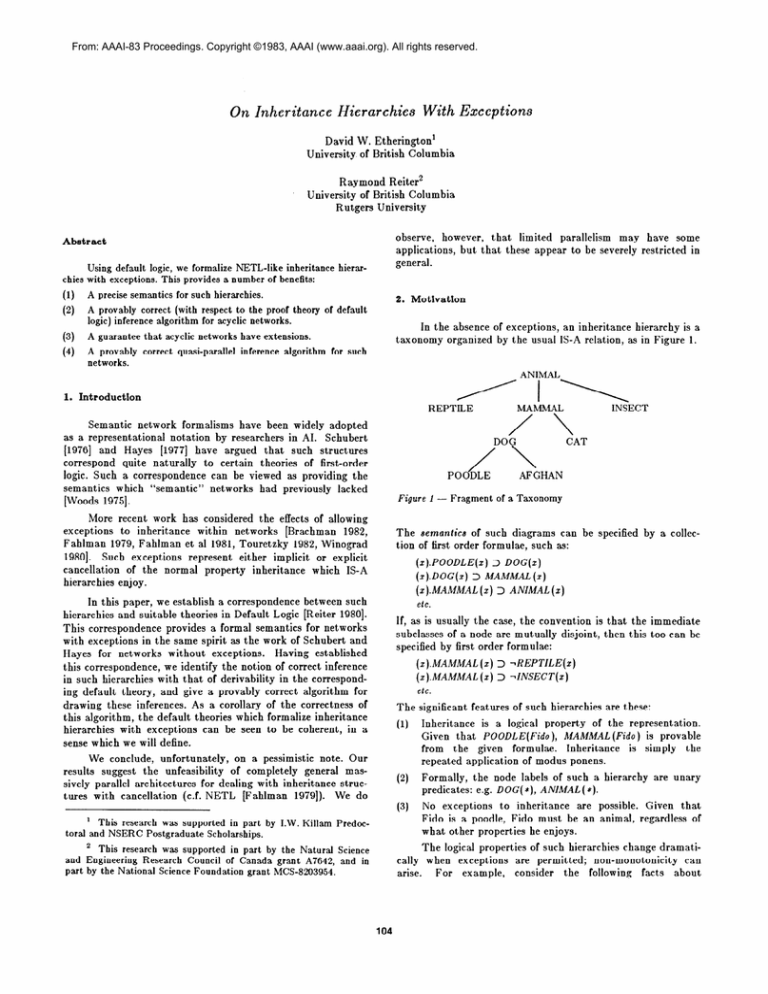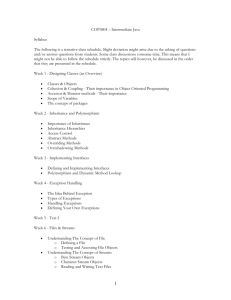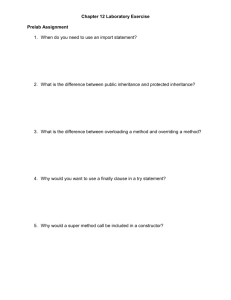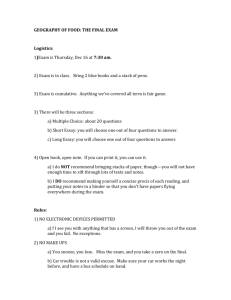
From: AAAI-83 Proceedings. Copyright ©1983, AAAI (www.aaai.org). All rights reserved.
On Inheritance
With Exceptions
Hierarchies
David
University
W. Etherington’
of British Columbia
Raymond
Reiter2
University
of British Columbia
Rutgers
University
Abstract
Using default logic, we formalize NETL-like inheritance
chies with exceptions. This provides a number of benefits:
hierar-
(1)
A precise semantics for such hierarchies.
(2)
A provably correct (with respect to the proof theory of default
logic) inference algorithm for acyclic networks.
(3)
A guarantee that acyclic networks have extensions.
(4)
A provably
networks.
correct quasi-parallel
inference algorithm
observe,
however,
that
limited
parallelism
may have some
applications,
but that these appear to be severely restricted
in
general.
2. Motivation
In the absence
taxonomy
organized
of exceptions,
by the usual
an inheritance
IS-A relation,
hierarchy
is a
as in Figure 1.
for such
ANIMAL
/
1. Introduction
I \
MAGMAL
REPTILE
Semantic
network
formalisms
have been widely adopted
as a representational
notation
by researchers
in AI. Schubert
[1976] and Hayes
[1977] h ave argued
that
such structures
correspond
quite naturally
to certain
theories
of first-order
logic. Such a correspondence
can be viewed as providing
the
semantics
which “semantic”
networks
had previously
lacked
[Woods 19751.
More recent work has considered
the effects of allowing
exceptions
to inheritance
within
networks
[Brachman
1982,
Fahlman
1979, Fahlman
et al 1981, Touretzky
1982, Winograd
19801. Such exceptions
represent
either
implicit
or explicit
cancellation
of the normal
property
inheritance
which IS-A
hierarchies
enjoy.
In this paper, we establish
a correspondence
between such
hierarchies
and suitable theories in Default Logic [Reiter 19801.
This correspondence
provides
a formal semantics
for networks
with exceptions
in the same spirit as the work of Schubert
and
Hayes for networks
without
exceptions.
Having
established
this correspondence,
we identify the notion of correct inference
in such hierarchies
with that of derivability
in the corresponding default
theory,
and give a provably
correct
algorithm
for
drawing
these inferences.
As a corollary
of the correctness
of
this algorithm,
the default theories which formalize
inheritance
hierarchies
with exceptions
can be seen to be coherent,
in a
sense which we will define.
We conclude,
unfortunately,
on a pessimistic
note. Our
results
suggest
the unfeasibility
of completely
general
massively parallel architectures
for dealing with inheritance
structures with cancellation
(c.f. NETL
[Fahlman
19791). We do
’ This research was supported in part by I.W. Killam
toral and NSERC Postgraduate Scholarships.
/
Figure 1 -
CAT
POODLE
AFGHAN
Fragment
of a Taxonomy
The 8emantico of such diagrams
tion of first order formulae,
such
(z).POODLE(z)
(x).DOG(z)
can
as:
be specified
by a collec-
3 DOG(z)
3 MAMMAL
(z).MAMMAL(z)
(2)
3 ANIMAL(z)
etc.
If, as is usually the case, the convention
is that the immediate
subclasses
of a node are mutually
disjoint,
then this too can be
specified by first order formulae:
(z).MAMMAL
(2) 3
7REPTILE(
(s).MAMMAL
(2) 3
-INSECT(z)
z)
etc.
The significant
features
of such
hierarchies
are these:
(1)
Inheritance
is a logical property
of the representation.
POODLE(Fido),
MAMMAL (Fido) is provable
Given that
from
the given
formulae.
Inheritance
is simply
the
repeated
application
of modus ponens.
(2)
Formally,
the node labels of such a hierarchy
predicates: e.g. DOG( *), ANIMAL ( *).
(3)
No exceptions
to inheritance
are possible.
Fido is a poodle, Fido must be an animal,
what other properties
he enjoys.
Predoc-
’ This research was supported in part by the Natural Science
and Engineering Research Council of Canada grant A7642, and in
part by the National Science Foundation grant MCS-8293954.
\
DOG
/\
INSECT
cally
arise.
are unary
Given
that
regardless
of
The logical properties
of such hierarchies
change dramatiwhen exceptions
are permitted;
non-monotonicity
can
consider
the
following
facts
about
For
example,
elephants:
(1)
Elephants
are gray,
except
for albino
(2)
All albino
elephants
are elephants.
have multiple
extensions
- an undesirable
feature,
see - then b may inherit different sets of properties
on which extension
is chosen.
elephants.
It is a feature of our common sense reasoning
about prototypes
like “elephant”
that, when given an individual
elephant,
say
Fred, not known to be an albino, we can infer that he is gray.
If we subsequently
discover - perhaps
by observation
- that
Fred is an albino elephant,
we must retract
our conclusion
about
his grayness.
Thus,
common
sense reasoning
about
exceptions
is non-monotonic,
in the sense that new information can invalidate
previously
derived facts. It is this feature
which precludes
first order representations,
like those used for
taxonomies,
from formalizing
exceptions.
3. A Sernantica
tions
Inheritance
(1)
(2)
(3)
&I) : B(h...AJ
7(%.-A)
B: A’s are never B’s.
statement,
identified
Strict ISN’T-A:
A.-.
Again,
this is a universal
(x).A(x) 3 -B(x).
Excep-
the first
with:
>.B:
Normally
A’s are B’s, but
Default IS-A: A.there may be exceptions.
To provide for exceptions,
we identify this with a default:
: B(z)
B(z)
(4)
Default
ISN’T-A:
B’s, but exceptions
Identified with:
>.B:
A.*
are allowed.
: -B
A(z)
: GRAY(z)
With
.B: A’s are always B’s.
Strict IS-A: A.d
Since this is universally
true, we identify
it with
order formula:
(x).A(x) 3 B(x).
A(x)
where CX,B, and 7 are first order formulae
whose free variables
are among
z1,...,2,. Informally,
such a default
can be understood to say: For any individuals
z~,...,z,, if a(zl,...,z,)
is inferrable and a(~,,... ,x,) can be consistently
assumed,
then infer
For our elephant
example,
the first statement
7(Sl,...,Z,).
would be represented
by a default:
ELEPH.4NT(x)
Hierarchies
We now show that Default
Logic can provide
a formal
semantics
for inheritance
structures
with exceptions.
We
adopt a network
representation
with five link types.
Although
other
approaches
to inheritance
may omit one or more of
these, our formalism
subsumes
these as special cases. The five
link types,3 with their translations
to default logic, are:
In recent years, there have been several
proposed
formalisms for such non-monotonic
reasoning
(See e.g. [AI 19801). For
the purpose
of formalizing
inheritance
hierarchies
with exceptions, we shall focus on one such proposal
Default
Logic
(Reiter 19801. A default
theory consists of a set, W, of ordinary first order formulae,
together
with a set, D, of rules of
have the form:
inference called defaults. In general, defaults
+1,...,
for
as we shall
depending
8 -ALBINO-ELEPHANT(x)
Normally
A’s are not
z
-B(x)
GRAY(z)
(5)
From the informal
reading
of this default,
one can see that
only
ELEPHANT(Fred),
GRAY(Fred)
&
when
given
TALBINO-ELEPHANT(Fred)
is consistent
with this; hence
GRAY(Fred)
may be inferred.
On the other
hand, given
conclude
can
one
ALBlNO-ELEPHANT(Fred)
ELEPHANT(Fred)
using
the first order
fact (x).ALBINOALBINOELEPHANT(x),
but
ELEPHANT(x)
3
the default,
thereby
preventing
ELEPHANT(Fred)
“blocks”
the derivation
of GRAY(Fred),
as required.
Exception:
A.------>
The exception
link has no independent
semantics;
rather,
it serves only to make explicit the exceptions,
if any, to
the above default
links. There must always be a default
link at the head of an exception
link; the exception
then
alters the semantics
of that default
link. There are two
types of default
links with exceptions;
their graphical
structures
and translations
are:
B.
The formal details of Default Logic are beyond the scope
of this paper. Roughly
speaking,
however, for a default theory,
(D,W), we think of the defaults
of D as extending
the first
W and
order theory
given by W. Such an extension contains
is closed under the defaults
of D as well as first order theoremhood.
It is then natural
to think of an extension
as defining
the “theorems”
of a default
theory;
these are the conclusions
sanctioned
by the theory.
However, these extensions
need not
be unique [Reiter 19801. F or a default theory with more than
one extension,
any one of its extensions
is interpreted
as an
acceptable
set of beliefs that
one may entertain
about
the
world represented
by that theory.
A(z)
: B(z)
-_ .
\\
. . .
A Cl
In the next section, we show how inheritance
hierarchies
with exceptions
can be formalized
as default theories.
Default
Logic will then be seen to provide a formal semantics
for such
hierarchies,
just as first order logic does for IS-A hierarchies.
As was the case for IS-A hierarchies,
inheritance
will emerge as
a logical
feature
of the representation.
Those
properties,
b, inherits
will be precisely
PI, * . . , P,, which an individual,
those for which P,(b), . . .. P,(b) all belong to a common extension of the corresponding
default
theory.
Should
the theory
We illustrate
with
...
d -C,(z)
@...@I +&(z)
B(z)
c,
an example
from
[Fahlman
et al I98I].
Molluscs are normally shell-bearers.
Cephalopods must be Molluscs but normally are not shell-bearers.
Nautili must be Cephalopods and must be shell-bearers.
’ Note that strict and default links are distinguished
and open arrowheads, respectively.
105
by solid
Our network
representation
of these
facts
is given
in Figure
2.
Shell-bearer
Mollusc
Cephalopod
\I
Nautilus
Figure 2 -
Network
. -’
representation
The corresponding
default
M(z)
63 -C(z)
{
: Sb(z)
/I
theory
: +b(z’
+b(z)
’ 1N(z’,
Given a particular
in which it is also
A Cephalopod
not
a Mollusc with no
about Molluscs.
is:
, (W(Z)
SW
‘(”
of our knowledge
3 M(z),
(z).N(z)
(z).N(z’
3
C(z),
> Sb(x)}.
Nautilus,
this theory has a unique extension
a Cephalopod,
a Mollusc, and a Shell-bearer.
known to be a Nautilus
will turn out to be
shell.
It is instructive
with those of NETL
that in NETL there
links are potentially
over, NETL
allows
ISN’T-A (*CANCEL)
2 to NETL-like
links,
to compare
our network
representations
[Fahlman
et al 19811. A basic difference is
are no strict links; all IS-A and ISN’T-A
cancellable
and hence are defaults.
Moreexception
(*UNCANCEL)
links only for
links. If we restrict
the graph of Figure
we get Figure 3,
NETL, on the other hand, cannot make this exception
explicit
in the graphical
representation,
since it does not permit excep
tion links to point to IS-A links.
How then does NETL conclude
that a Cephalopod
is not
a Shell-bearer,
without
also concluding
that
it is a Shellbearer?
NETL resolves such ambiguities
by means of an inference procedure
which
prefers
shortest
paths.
Interpreted
in
terms
of default
logic,
this
“shortest
path
heuristic”
is
intended
to favour one extension
of the default theory.
Thus,
in the example
above, the path from Cephalopod
to +hellbearer is shorter
than that to Shell-bearer
so that, for NETL,
the former wins. Unfortunately,
this heuristic
is not sul?icient
to replace the excluded
exception
type in all cases.
Reiter and
[1982] show that it can lead
Criscuolo
[1983] and Etherington
to conclusions
which are unintuitive
or even invalid - i.e. not
Fahlman
et al [1981] and Touretzky
[1981,
in any extension.
19821 have also observed
that such shortest
path algorithms
can lead to anomalous
conclusions
and they describe attempts
to restrict
the form of networks
to exclude
structures
which
From the perspective
of default
logic,
admit such problems.
these restrictions
are intended
to yield default
theories
with
unique extensions.
An inference
algorithm
for network
structures
is correct
only if it can be shown to derive conclusions
all of which lie
within
a single extension
of the underlying
default
theory.
This criterion
rules out shortest
path inference for unrestricted
networks.
In the next section, we present
a correct
inference
algorithm.
4. Correct
Inference
The
correspondence
theories requires defaults
a(q,
Shell-bearer
. . . A)
between
all of which
networks
and
have the form:
: a(% . * * AJ f.3 7(x,, . . . 9,)
default
4
B(Zl, . * * J,)
Mollusc
Cephalopod
Figure 9 -
NETL-like network
about Molluscs.
which is essentially
the graph
corresponds
to the theory:
{
M(x)
CX
C(z)
: Sb(x)
Sb(z)
: -Sb z
+b(z)
’
B -N
representation
given
: M(z)
M(z)
x)
,
by Fahlm an. This
N(x)
’
of our knowledge
network
: C(z)
C(z)
N(z) : Sb(z)
Sb(z)
Such defaults
are called aemi-normal
, and can be contrasted
with normal defaults,
in which 7(z1, . . . , zn) is a tautology.
Our criterion
for the correctness
of a network
inference
algorithm requires that it derive conclusions
all of which lie within
a single extension
of the underlying
default
theory.
Until
recently,
the only known methods
for determining
extensions
were restricted
to theories
involving
only normal
defaults
[Reiter 19801. Etherington
[1982] has developed
a more genwhich
involves
a relaxation
style constraint
eral procedure,
This
procedure
takes
as input
a
propagation
technique.
where
D is a finite set of closed
default
theory,
(D,W),
defaults,5
and W is a finite set of first order formulae.
In the
presentation
of this procedure,
below, the following notation
is
used:
’
”
As before, a given Nautilus
will also be a Cephalopod,
a Mollust, and a Shell-bearer.
A Cephalopod
not known to be a
Nautilus,
however,
gives rise to two extensions,
corresponding
to an ambivalence
about whether
or not it has a shell. While
counter-intuitive,
this merely indicates
that an exception
to
shell-bearing,
namely being a Cephalopod,
has not been explicitly represented
in the network.
Default
Logic resolves the
ambiguity
by making
the exception
explicit,
as in Figure
2.
S k w means
S k w means
CONSEQUENT(
formula w is first order provable
that w is not first order provable
y)
is defined
from premises
from S.
S.
to be 7.
4 a(q, . . . ,z,) and (a(~,, . . . ,z,) d r(zl, . . . ,zn)) are called
the prerequisite and justification of the default, respectively.
6 A default,
(y: B is closed iff CY,B, and 7 contain no free
7 ’
variables.
H,, +
W;
the procedure
is applied
to this theory,
it generates
the
in each approximation
shown.
(The formulae
approximations
a& listed in the order in‘ which they are derived.)
-D occurs
before 6.
in HI since it can be inferred
j + 0;
repeat
j+j+
1; h,+
W;
CD,+{};
i+O;
repeat
Di + { +
6 D I (hi I-- 4, (h, bc -a), W,-I bc -B) 1;
if lnull(Di
The following
- CDi) then
choose S from (Di - GDJ;
GDi+, +
hi+l +
i+i+
GDi U
h, U
{6);
{CONSEQUENT(G)};
end&
As a simple
1;
hi-,
Extensions
are constructed
by a series of successive
approximations.
Each approximation,
Hj, is built up from any
first-order
components
by applying
defaults,
one at a time. At
each step, the default
to be applied is chosen from those, not
are “known”
and whose
yet applied,
whose
prerequisites
justifications
are consistent
with both the previous approximation and the current
approximation.
When no more defaults
are applicable,
the procedure
proceeds
to the next approximation. If two successive
approximations
are the same, the procedure is said to converge.
19831:
inherialwaya
we have:
Even in knowledge
bases with unique extensions,
structures requiring
an arbitrarily
large radius
of communication
can
be created.
For example,
both
the default
theories
corresponding
to the networks
in Figure 5 have unique ex tensions. A network
inference
algorithm
must reach
F before
propagating
through
B in the first network
and conversely
in
the second.
The salient distinctions
between the two networks
are not local; hence they cannot
be utilized to guide a purely
local inference
mechanism
to the correct choices.
Similar networks can be constructed
which defeat marker
passing
algorithms with any fixed radius.
Ezample
Consider
the network
of Figure 4. Given an instance
of
A, the corresponding
default theory has a unique extension
in
which A’s instance
is also an instance
of B, C, and D. When
H2
C )
= ( A, B, C )
H, =
./7:3t.
--7.
F
&={A)
{ A, B, -D,
H., =
Algorithms
The formalization
of such networks
as default
theories
however,
that there might be severe limitations
to
suggests,
this approach.
For example,
correct inference requires that all
conclusions
share
a common
extension.
For networks
with
more than one extension,
inter-extension
interference
effects
must be prevented.
This seems impossible
for a one pass parallel algorithm
under purely local control,
especially
in view of
the inadequacies
of the shortest
path heuristic.
extension.
For
that P(b), P,(b), .... P,(b), belong to a common
it is clear that
predicate
arguments
can be
this problem
ignored; the appropriate
default theory becomes purely propositional. For propositional
logic, non-provability
is computable.
H, =
It says that such networks
are
that they define at least one
the world represented
by the
The computational
complexity
of inheritance
problems,
combined
with
some
encouraging
examples,
has sparked
interest
in the possibility
of performing
inferences
in parallel.
Fahlman
[1979] has proposed
a massively
parallel
machine
architecture,
NETL.
NETL
assigns
one processor
to each
predicate
in the knowledge
base.
“Inferencing”
is performed
“markers”
to adjacent
nodes in response
to
by nodes passing
both their own states and those of their immediate
neighbours.
Fahlman
suggests
that such architectures
could achieve logarithmic speed improvements
over traditional
serial machines.
Notice that there are appeals
to non-provability
in this
procedure.
In general,
such tests are not computable,
since
arbitrary
first order formulae
are involved.
Fortunately,
such
difficulties
disappear
for default
theories
corresponding
to
inheritance
hierarchies.
For these theories,
all predicates
are
unary.
Moreover,
for such theories,
we are concerned
with the
following problem:
Given an individual,
b, which is an instance
P, determine
all other predicates
which b inherof a predicate,
its - i.e. given P(b) determine
all predicates,
PI, . . . , P,, such
of Procedure
corollary
5. Parallel Inference
The choice of which default
to apply at each step of the
inner loop may introduce
a degree of non-determinism.
Generality
requires
this non-determinism,
however,
since extensions are not necessarily
unique. Deterministic
procedures
can
be constructed
for theories which have unique extensions,
or if
full generality
is not required.
Example
in (Etherington
The latter result is comforting.
in the sense
always
coherent,
acceptable
set of beliefs about
network.
untll HJ = Hjel
Figure 4 -
is proved
The default theory corresponding
to an acyclic inheritance network with ezceptione
ha8 at leaat one eztension.
until r~ull(D1-~- GDkl);
Hj =
result
For default theories
corresponding
to acyclic
tance networka
with ezceptiona,
the procedure
convergea on an extension.
T .
D
{ A, B, D, C )
A
T ./
Figure 5a
Behaviour
107
B
B
F
E
7.
D
T .
A
1 ./
Figure 56
8. References
Touretzky
[1981] h as observed
such behaviour
and has
developed
restrictions-on
network
structures
which admit parrallel inferencing
algorithms.
In part, such restrictions
appear
to have the effect of limiting the corresponding
default theory
to one extension.
Unfortunately,
it is unclear
how these restrictions
affect the expressive
power of the resulting
networks.
Moreover,
Touretzky
has observed
that it is not possible to
determine
in parallel whether
a network
satisfies these restrictions.
AI (1986) Special issue on non-monotonic
13 (1,2), April.
Brachman,
Reasoning
D.W. (1983), F ormaliting Non-monotonic
Dept. Computer Science, University of B.C.
(To appear).
Systems, TR-83-1,
S.E. (1979), NETL:
Real- World Knowledge,
Fahlman,
2)
R. (1980),
“A
Artificial Intelligence
of Logic”,
Proc. IJCAI-77,
for
Default
Logic
13, (April) pp 81-132.
Cam-
Reasoning”,
Reiter, R., and Criscuolo, G. (1983), “Some Representational Issues
Int. J. Computers and Mathematics,
in Default Reasoning”,
(Special
Issue on Computationd Linguistics), to appear.
. -
provably
Schubert, L.K. (1976) “Extending the Expressive Power of Semantic
Networks”, Artificial Inte!!igence 7(2), pp 163-198.
Touretzky,
Winograd,
T. (1980)
in an Inheritance
Hierarchy”,
“Extended Inference Modes in Reasoning”,
13, (April), pp 5-26.
Artificial Intelligence
Woods,
W.A. (1975),
“What’s
In A Link?“,
Understanding, Academic Press, pp 35-82.
Define such a parallel algorithm
and prove its correctness
with respect to the derivability
relation of default logic.
to resIn connection
with (la), notice that it is natural
trict attention
to those hierarchies
whose corresponding
default
theories
have
unique
extensions.
Characterize
such hierarchies.
7. Acknowledgments
would
like to thank
Robert
Mercer
and
for their valuable
comments
on earlier drafts
D.S. (1981) Personal Communication.
Touretzky, D.S. (1982), “Exceptions
Unpublished Manuscript.
Determine
a natural
class of inheritance
hierarchies
with
exceptions
which admits
a parallel
inference
algorithm
yet does not preclude
the representation
of our commonsense knowledge
about taxonomies.
We
Touretzky
paper.
P. J. (1977), “In Defense
bridge, Mass., pp 559-565.
Reiter,
Cur formalization
suggests
that for unrestricted
hierarchiea, it may not be possible
to realize
massively
parallel
marker
passing
hardware
of the kind envisaged
by NETL.
Fortunately,
this pessimistic
observation
does not preclude
parallel
architectures
for suitably
restricted
hierarchies.
This
raises several open problems:
lb)
A System For Representing and Using
MIT Press, Cambridge, Mass.
Fahlman, S.E., Touretzky, D.S., and van Roggen, W. (1981), “Cancellation in a Parallel Semantic Network”, Proc. ZJCAI-81,
Vancouver, B.C., Aug. 24-28, pp 257-263.
By formalizing
inheritance
hierarchies
with exceptions
using default
logic we have provided
them with a precise
semantics.
This in turn allowed
us to identify
the notion of
correct inference
in such a hierarchy
with that of derivability
within a single extension
of the corresponding
default
theory.
We
then
provided
an
inference
algorithm
for
acyclic
la)
Studies
Etherington,
Hayes,
is
Proc. Canadian
of Intelligence-82,
Saskatoon,
‘IS-A’ Is and Isn’t”,
Etherington,
D.W. (1982)
Finite Default Theories,
M.Sc. Thesis,
Dept. Computer Science, University of British Columbia.
0. Conclusion8
hierarchies
with
exceptions
which
respect to this concept of derivability.
“What
Computational
Sask., May 17-19, pp 212-220.
A form of limited parallelism
can be achieved
by partitioning
a network
into a hierarchy
of subnetworks,
using an
algorithm
given in [Etherington
1983). A parallel algorithm
can
then be applied
to the individual
subnets,
in turn.
The
number of subnets
which must be processed
is bounded
by the
number
of exception
links in the network.
Unfortunately,
it
can be shown that this technique
may exclude some extensions
of the theory.
We have not yet characterized
the biases which
this induces in a reasoner.
inheritance
correct with
R. (1982),
Sot. for
logic, Artificial Intelligence
David
of this
108
Representation
and







